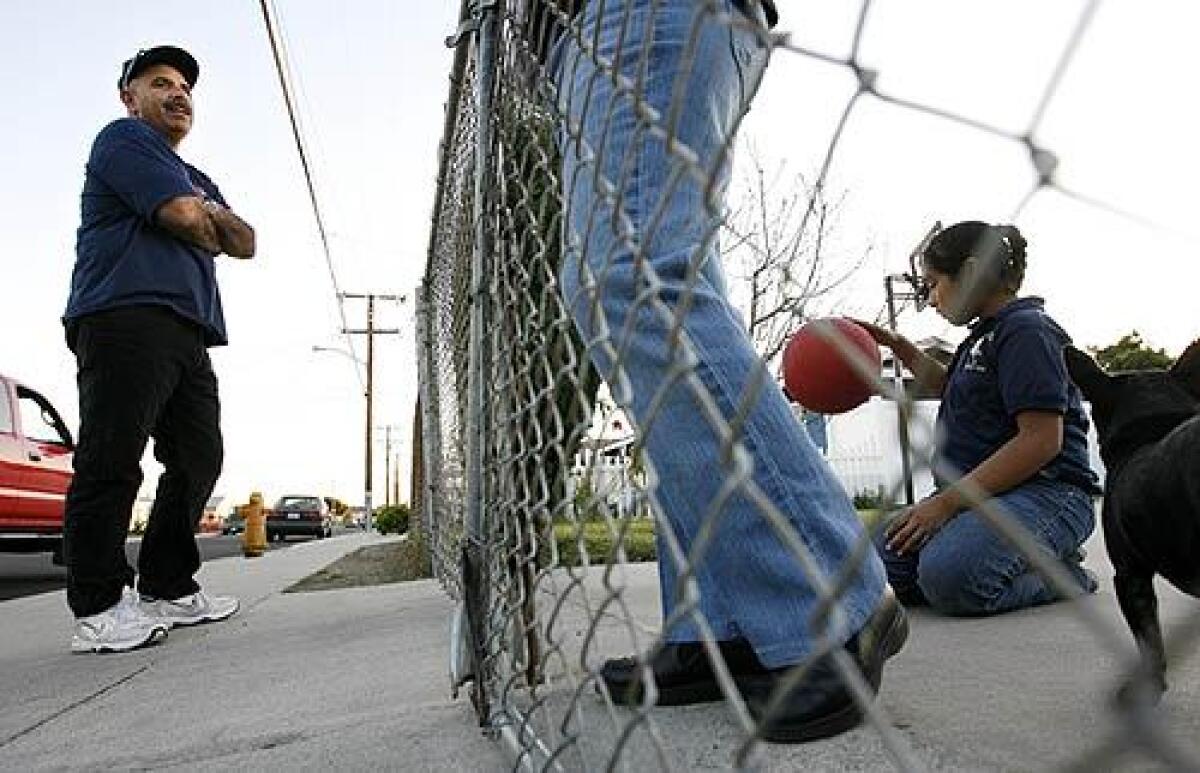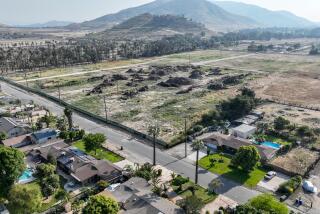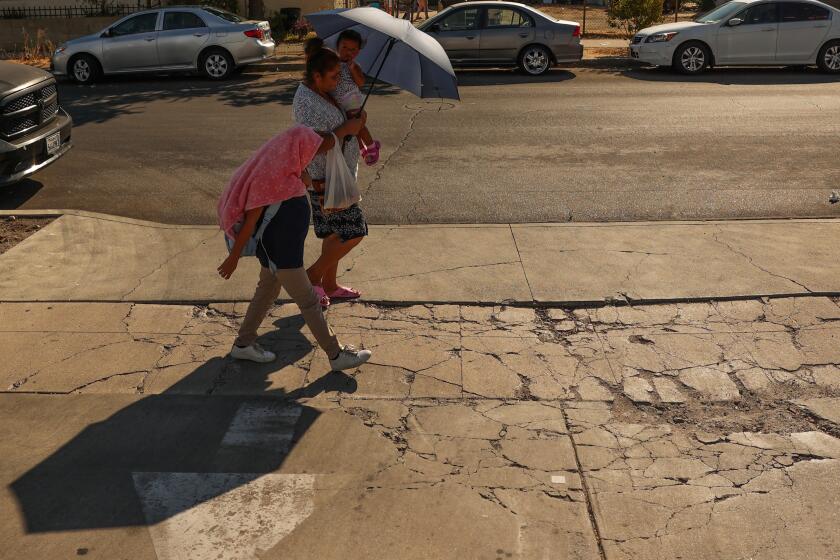Tiny Latino neighborhood has resisted joining Anaheim

Even at 10 miles from the sea, they live on an island.
Their mailing addresses say Anaheim, but for generations the families of Colonia Independencia have lived in a municipal no man’s land, a barrio settled long ago by the migrants who worked Orange County’s farmland.
Now, the roughly 200 families in the generations-old Latino immigrant neighborhood are being urged -- pressured, some say -- to become a part of one of the state’s largest cities.
It’s not a simple question in a place where residents have invested so much. They have poured the cement for the neighborhood’s basketball court, planted the grass in the park, operated their own water district and gathered as their children were baptized and married at the Misión del Sagrado Corazón, the neighborhood’s 83-year-old Catholic church.
Yet in the eyes of some, the three-block neighborhood of simple wood and stucco houses sitting on large lots is feeling its age and could use a helping hand.
Paint peels from abandoned houses that have stood empty for years. Makeshift plumbing and rickety storage sheds have popped up in the absence of steady code enforcement. Nearly every night, teenagers throw trash over backyard fences at the sheriff’s cruisers patrolling for gang activity.
Southern California is peppered with neighborhoods that have resisted being pushed into cityhood, from historic barrios to planned subdivisions -- holdouts such as tiny Rossmoor along the Los Angeles-Orange County line and Hacienda Heights in the San Gabriel Valley.
But the debate in Colonia Independencia runs deep. Some worry that the neighborhood’s character and sense of independence will wither if it throws in with Anaheim; others think becoming part of Anaheim is the only way to root out gang violence and blight.
La Colonia, as residents call the neighborhood, is tucked into a 500-acre unincorporated swath known as the Southwest Island, surrounded by Anaheim, Garden Grove and Stanton. Residents, used to relying on strained county government for basic services such as street sweeping and policing, have been warned for years that county officials are eager to get such outposts off their hands and dump the expenses on local cities.
Residents of La Colonia rejected annexation in 2005. Government officials have changed tacks, now going after residents house by house and urging them to agree to become part of Anaheim.
To officials in Anaheim, taking on the neighborhood is simply the right thing to do: It would consolidate the city with surrounding communities, give residents more reliable services and provide the expanded voting rights and steadier hand of a city government.
“It’s inevitable that all that area will be part of a city,” Anaheim Mayor Curt Pringle said. “It’s not going to be some island forever.”
The specter of cityhood has stoked fear and suspicion in La Colonia. Adopting the mostly residential area would cost the city more than the tax money it would gain, and many residents wonder why Anaheim even wants them.
Neighborhood skeptics fear that if residents give in, Anaheim will raze their neighborhood for redevelopment and transportation improvements, including the current widening of nearby Katella Avenue.
Liz Sepeda, 66, who has lived in the neighborhood since she was 19, worries that becoming part of Anaheim would make it easier for the government to drive out property owners, one home at a time.
“You can give me $800 million, but I’m never leaving,” she said.
The people of La Colonia are mostly descendants of Mexican farmhands and construction workers who built their homes next to citrus groves in the 1920s and ‘30s. Every year, they hold community reunions to leaf through old photo albums and recall the days when pastimes included cheering on Mexican American baseball teams such as the Sunkist Guadalupanos.
Back then, dozens of barrios sprouted outside city limits along Southern California’s train tracks, giving migrant workers easy access to jobs and transportation. Many were displaced by tract homes, but La Colonia remains.
As they put down roots, residents had to take care of the community themselves, fighting for sidewalks, streetlights and a community center in the old schoolhouse.
“We’re like a stepchild to the county,” said Alice Conatser, 52, who has not made up her mind on annexation. “We do what we want, and nobody tells us what to do.”
In 2005, more than half of the registered voters in the Southwest Island signed a petition defeating an annexation attempt. But last October, the county returned. In a letter that began, “Dear Island resident,” Orange County Supervisor Chris Norby asked each property owner to “take another look” at the advantages of incorporation, which include better tax revenues from tourism.
Under the new plan, city-adjacent property owners could individually apply to join Anaheim. In exchange, the Orange County Local Agency Formation Commission would waive the normal $7,200 fee, and Anaheim would absorb some of the other costs.
At a community meeting last month, Carolyn Emery, senior project manager for the boundary agency, said new Anaheim residents would see few changes other than more frequent street cleaning and the protection of Anaheim police officers instead of sheriff’s deputies.
Anaheim, she said, is willing to sweep streets for as few as five homes, should they choose to join the city.
Since the fall, the agency has received more than 90 applications from Southwest Island property owners, but only four are from La Colonia.
Fueling the debate, the Assn. of Orange County Deputy Sheriffs mailed out fliers opposing annexation because it reduces their patrol area. The group has opposed such incorporation moves in the county in the past.
Ray Ontiveros, 51, a third-generation La Colonia resident who owns several homes in the community, supports annexation because he thinks Anaheim can better deal with the local gang problems and crack down on unapproved construction projects, unlicensed catering-truck businesses and deteriorating homes.
“It’s like the Wild West here,” Ontiveros said. “Anyone can build a house here without permit. It’s been going on for years.”
Others worry that piecemeal annexation will divide the neighborhood, with some families claiming allegiance to Anaheim and their next-door neighbors to the county.
“I don’t like to see something fixed that’s not broken,” said Alberto M. Blackwood Sr., who has lived in La Colonia nearly 50 years. “I like it the way it is.”
He also wonders if eminent domain looms and if the 40-foot flagpole that has sat in his frontyard for years flying the POW/MIA and U.S. flags would be a target of Anaheim code enforcers.
Pringle, the mayor, said that nothing of the sort is planned. The city has a policy prohibiting it from taking property for private use, he said, and officials would work with homeowners to grandfather in any unconventional uses -- even the raising of livestock.
“If they have a potbellied pig, there’s not going to be city code enforcement taking it away,” he said.
Conatser, for one, is torn about La Colonia’s future. She fears that the annexation debate itself could erode the sense of community in the neighborhood, spreading confusion and speculation.
“How can you be in one city and the neighbor’s not?” she wonders.
It’s a question she’s hoping to put off until another day.
More to Read
Sign up for Essential California
The most important California stories and recommendations in your inbox every morning.
You may occasionally receive promotional content from the Los Angeles Times.











